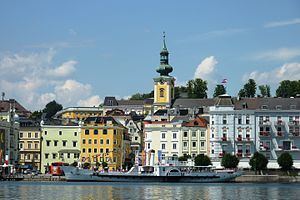Country Austria District Gmunden Postal code 4810 Elevation 425 m | Time zone CET (UTC+1) Area code 07612 Population 13,195 (1 Apr 2009) | |
 | ||
Weather 9°C, Wind W at 5 km/h, 79% Humidity Points of interest Schloss Ort, Traunstein, Grünberg, K‑Hof Kammerhofmuseen Gmunden, Rathaus Gmunden | ||
Gmunden ([ˈɡmʊndən]) is a town in Upper Austria, Austria in the district of Gmunden. It has 13,204 inhabitants (estimates 2016 ). It is much frequented as a health and summer resort, and has a variety of lake, brine, vegetable and pine-cone baths, a hydropathic establishment, inhalation chambers, whey cure, etc. It is also an important centre of the salt industry in Salzkammergut.
Contents
- Map of 4810 Gmunden Austria
- Geography
- Municipal arrangement
- Population
- History
- Politics
- Main sights
- Education
- People
- Famous residents
- References
Map of 4810 Gmunden, Austria
Geography
Gmunden covers an area of 63.49 square kilometres (24.51 sq mi) and has a median height of 425 metres (1,394 ft). It is situated next to the lake Traunsee on the Traun River and is surrounded by high mountains, including the Traunstein (mountain) (5,446 feet or 1,660 metres), the Erlakogel (5150 ft), the Wilder Kogel (6,860 feet or 2,090 metres) and the Höllengebirge.
Municipal arrangement
Gmunden is divided into the following boroughs: Gmunden, Gmunden-Ort, Schlagen, Traundorf, Unterm Stein.
Population
As of 2001, Gmunden had a population of 13,336. Of that, 88.4% were Austrian in nationality, 1.5% are from other European Union states, and 10.2% are other foreigners. Citizens of Bosnia-Herzegovina (3.6%) and the former Federal Republic of Yugoslavia (2.7%) placed the strongest foreigner portion, followed by Turks (1.2%) and Germans (1.1%).
The majority (69.3%) confess themselves to the Roman Catholic Church. Evangelicals are next, which 7.3% of the population associate with. 5.9% are Muslims and 3.3% are Orthodox. 10.3% are nonreligious.
History
A settlement was in existence already in the fifth century AC. By 1186 Gmunden was a fortified place surrounded by walls, although it did not receive a church until about 1300. In 1278 Gmunden became a town. On November 14, 1626 an army of rebellious peasants was completely defeated at Gmunden by General Pappenheim, who had been ordered by Maximilian I to suppress the peasant rebellion in Upper Austria. The dead peasant insurgents were buried in nearby Pinsdorf, where an obelisk styled memorial known as the Bauernhügel in their honour can still be seen.
Gmunden supplied battleships to Austria during the 17th century and helped wounded soldiers in hospitals in World War I. During World War II, an SS maternity home was located here, "to insure racial purity" in accordance with Nazi racial theories.
Politics
The local council consists of 37 members. In the last municipal election in September 2015, the following are seats won by the political parties:
Mayors:
The current mayor is Stefan Krapf from ÖVP party. He became the mayor of Gmunden since 2014 replacing Heinz Köppl. The city council which includes of the mayor, consists of nine members; 5 from ÖVP, 2 from SPÖ, and 1 each from FPÖ and the Greens.
Main sights
There are a great number of excursions and points of interest round Gmunden, specially worth mentioning being the Traun Fall, 10 miles (16 km) north of Gmunden, a castle called Schloss Ort, and a ceramic factory producing Gmundner Keramik branded pottery. The town hall is also a popular tourist destination.
Education
In Gmunden there are four kindergartens, four elementary schools and three Hauptschulen. The three high schools are BG/BRG Gmunden, BRG Schloss Traunsee, and Gymnasium Ort.
